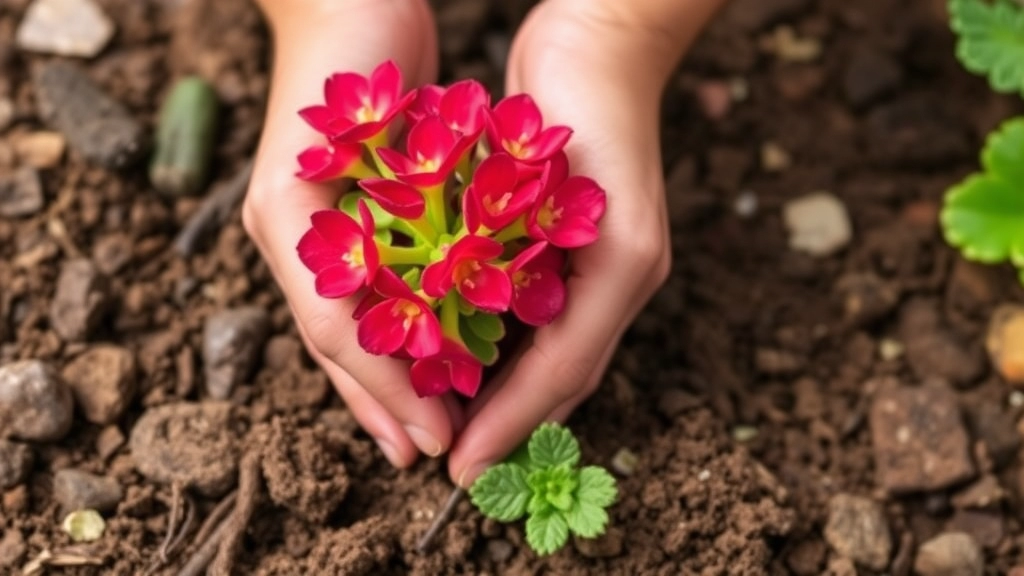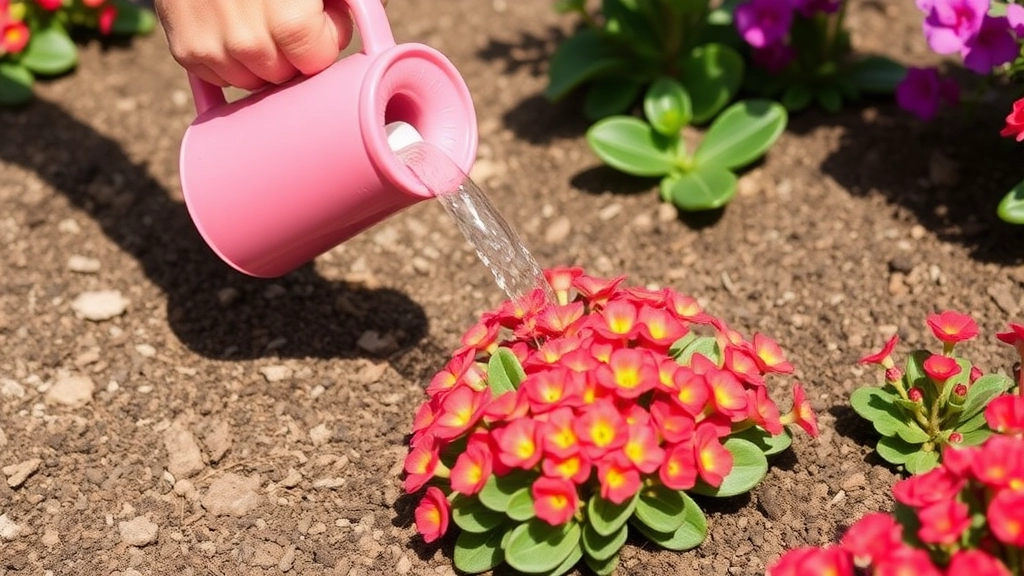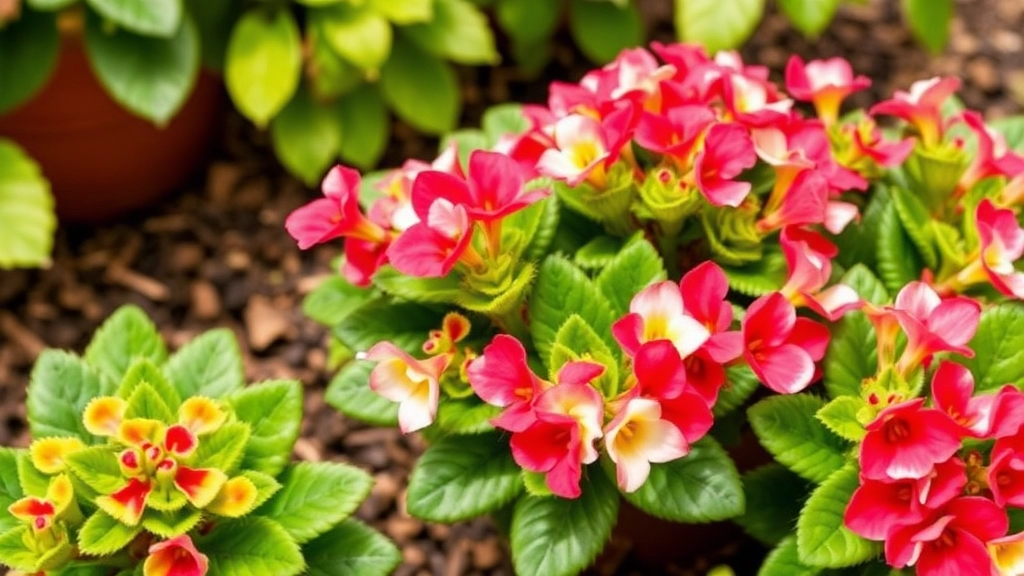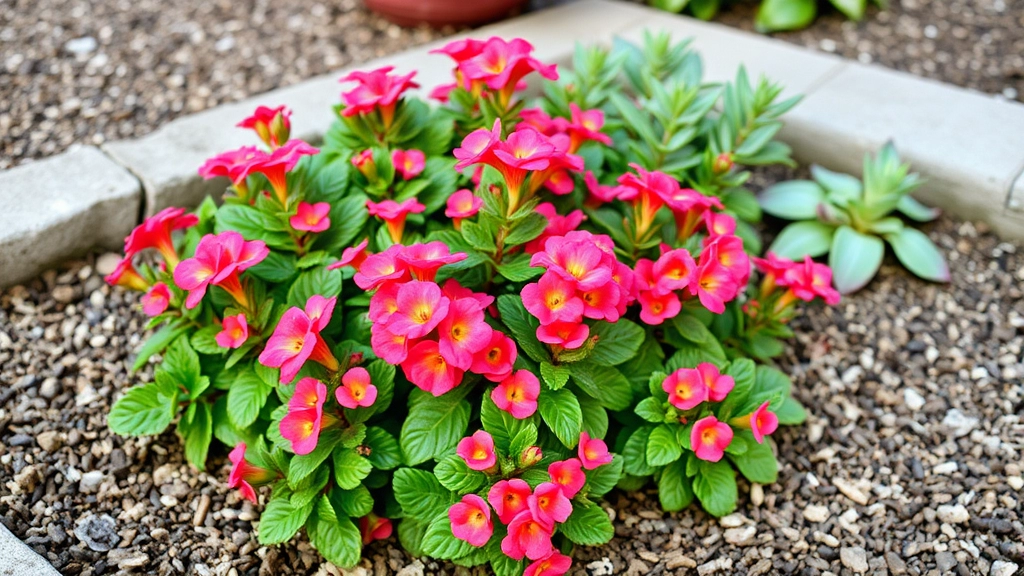Planting a Florist Kalanchoe Outdoor
Ever wondered how to successfully plant a Florist Kalanchoe outdoor in the ground? I’ve got you covered. This guide will walk you through the essential steps to ensure your Kalanchoe thrives outside. It’s all about choosing the right spot, prepping the soil, and giving it the care it needs.
Key Steps to Success
First off, location is key. Kalanchoe loves sunlight, so pick a spot where it can soak up the rays. Next, focus on the soil. It should be well-draining to prevent root rot. Once planted, water it moderately and watch it flourish. Follow these tips, and your Florist Kalanchoe will become the star of your garden.
When considering outdoor planting, one of the most pressing questions is: “Which Kalanchoe variety suits my garden best?”
Selecting the right variety is crucial for ensuring your Kalanchoe thrives in its new environment.
Here are some popular Kalanchoe varieties ideal for outdoor planting:
– **Kalanchoe blossfeldiana**: Known for its vibrant blooms, this variety adds a splash of colour to any garden.
– **Kalanchoe luciae**: Often referred to as the ‘Paddle Plant’, its unique leaf shape and colour make it a striking addition.
– **Kalanchoe tomentosa**: Commonly known as ‘Panda Plant’, its fuzzy leaves offer a unique texture to your garden.
– **Kalanchoe fedtschenkoi**: The ‘Chandelier Plant’ is perfect for hanging baskets, with its cascading growth habit.
Consider the following factors when choosing a variety:
– **Climate**: Ensure the variety you select is suitable for your local climate.
– **Sunlight**: Different Kalanchoe varieties have varying sunlight needs. Some prefer full sun, while others thrive in partial shade.
– **Soil Type**: Certain varieties may require specific soil conditions for optimal growth.
By taking these factors into account, you can select the perfect Kalanchoe variety that will flourish in your outdoor space. For more detailed guidance, you can refer to the [Kalanchoe blossfeldiana hybrid care guide](https://planthq.org/kalanchoe-blossfeldiana-hybrid-care-guide-tips-for-thriving-plants/) or learn more about [Kalanchoe tomentosa care](https://planthq.org/complete-care-guide-for-kalanchoe-tomentosa-teddy-bear/).
Preparing the Soil for In-Ground Kalanchoe

So, you’ve decided to plant Kalanchoe outdoors—great choice! But before you dig in, let’s talk about soil preparation.
You might be wondering, “What kind of soil does Kalanchoe need?”
Soil Type
Kalanchoe loves well-draining soil. Here’s what you should aim for:
- Sandy or Loamy Soil: This type drains well and prevents waterlogging.
- pH Level: Aim for a slightly acidic to neutral pH (around 6.0 to 7.0).
Enhancing Drainage
If your soil is heavy clay or doesn’t drain well, don’t worry! You can improve it:
- Add Sand: Mix in coarse sand to enhance drainage.
- Organic Matter: Incorporate compost or well-rotted manure to boost soil fertility.
Testing Your Soil
Before planting, it’s a good idea to test your soil. You can buy a simple kit online or at a garden centre. This helps you know what you’re working with and if any amendments are needed.
Preparing the Planting Area
Once you’ve got the right mix, it’s time to prepare your planting area:
- Clear the Area: Remove any weeds, rocks, or debris from the space.
- Loosen the Soil: Use a garden fork or tiller to aerate the soil.
- Mix in Amendments: If you’ve got compost or sand, mix it well into the top 12 inches of soil.
Final Touches
After you’ve prepped the soil, level it out. This ensures even water distribution and helps your Kalanchoe thrive.
Planting Techniques for Outdoor Kalanchoe
After selecting the right variety of Kalanchoe and preparing the soil, it’s time to delve into effective planting techniques. You may wonder how to ensure your Kalanchoe thrives in its new outdoor home.
Choosing the Right Time to Plant
Timing is crucial for planting Kalanchoe outdoors.
Watering and Fertilizing Kalanchoe in the Ground

After selecting the right Kalanchoe variety and preparing the soil, it’s time to focus on watering and fertilizing your outdoor plants.
Many gardeners worry about how much water their Kalanchoe needs. Overwatering can lead to root rot, while underwatering can stunt growth.
Watering Guidelines
- Frequency: Water your Kalanchoe every 2-3 weeks during the growing season (spring and summer). Reduce this to once a month in the dormant season (autumn and winter).
- Soil Check: Always check the top inch of soil. If it feels dry, it’s time to water.
- Watering Method: Water deeply but infrequently. This encourages deep root growth. Ensure that excess water drains away; Kalanchoe prefers well-drained soil.
Fertilizing Tips
Kalanchoe doesn’t require heavy fertilization, but a little boost can promote vibrant blooms.
- Type of Fertilizer: Use a balanced, water-soluble fertilizer, such as a 20-20-20 formula.
- Application Frequency: Fertilize every 4-6 weeks during the growing season. Avoid fertilizing in winter.
- Dilution: Always dilute the fertilizer to half-strength to prevent root burn.
Key Takeaways
- Water deeply every 2-3 weeks in spring and summer.
- Fertilize with a balanced solution every 4-6 weeks during the growing season.
- Always check soil moisture before watering.
When nurturing your outdoor Kalanchoe, one of the primary concerns is protecting them from pests and diseases. These resilient plants can still fall victim to various threats, and knowing how to safeguard them is crucial for their health and longevity.
Common Pests to Watch For:
– **Aphids**: These tiny insects can cluster on the leaves, sucking the sap and causing wilting.
– **Mealybugs**: Look for cotton-like tufts on the stems and leaves; they can weaken your plant significantly.
– **Spider Mites**: Tiny and often invisible to the naked eye, these pests can create fine webbing and cause leaf discolouration.
Preventative Measures:
– **Regular Inspections**: Check your Kalanchoe weekly for any signs of pests or disease.
– **Companion Planting**: Consider planting pest-repelling species nearby, like marigolds, to deter unwanted visitors.
– **Neem Oil**: A natural pesticide that can be sprayed on your plants to fend off pests without harming beneficial insects.
Signs of Disease:
– **Powdery Mildew**: A white, powdery substance on leaves indicates fungal infection.
– **Root Rot**: Yellowing leaves and a foul smell from the soil can suggest overwatering and root rot.
Quick Tips for Disease Prevention:
– **Good Air Circulation**: Ensure your Kalanchoe has enough space to breathe and dry out after watering.
– **Watering Techniques**: Water at the base rather than from above to keep leaves dry.
– **Healthy Soil**: Use well-draining soil to prevent moisture retention, which can lead to root diseases.
For more detailed care instructions, check out our [complete guide to Kalanchoe plant care](https://planthq.org/complete-guide-to-kalanchoe-plant-care/) and learn about [causes and solutions for brown spots on Kalanchoe leaves](https://planthq.org/causes-and-solutions-for-brown-spots-on-kalanchoe-leaves/).
Seasonal Care Tips for In-Ground Kalanchoe

So, you’ve got your Kalanchoe planted in the ground, and now you’re wondering how to keep it thriving through the seasons, right?
Spring: Time to Wake Up!
- As temperatures rise, check for any frost damage.
- Prune any dead or damaged leaves to encourage fresh growth.
- Start fertilising with a balanced, slow-release fertiliser to give your plant a boost.
Summer: Heat Management
- Ensure your Kalanchoe gets plenty of sunlight but watch out for scorching.
- Water deeply but less frequently; let the top inch of soil dry out before watering again.
- Consider mulching to retain moisture and keep roots cool.
Autumn: Preparation for Chill
- Gradually reduce watering as temperatures drop.
- Trim back any leggy growth to maintain a tidy shape.
- If you live in a colder area, consider covering your Kalanchoe with mulch or fabric during particularly chilly nights.
Winter: Protecting Your Plant
- If frost is expected, cover the plant with a frost cloth or bring potted Kalanchoe indoors.
- Cut back on watering; Kalanchoe needs less moisture when it’s dormant.
- Keep an eye out for pests that might seek warmth around your plant.
Common Issues and Troubleshooting for Outdoor Kalanchoe
As you nurture your outdoor Kalanchoe, you may encounter various challenges that can hinder its growth and vibrancy. Understanding these common issues is crucial for ensuring your plants thrive.
1. Overwatering and Root Rot
One of the most frequent problems is overwatering, leading to root rot. Signs include yellowing leaves and a mushy stem.
- Solution:
- Ensure that the soil drains well.
- Water only when the top inch of soil is dry.
- Consider using a potting mix designed for succulents.
2. Underwatering
Conversely, underwatering can also affect your Kalanchoe. If the leaves appear shrivelled or wrinkled, your plant may need more moisture.
- Solution:
- Water thoroughly, allowing excess to drain.
- Adjust your watering schedule based on the season.
3. Pest Infestations
Kalanchoe can attract pests like aphids and mealybugs. Look for sticky residue or webbing on the leaves.
- Solution:
- Use insecticidal soap or neem oil.
- Regularly inspect your plants for early signs of trouble.
4. Fungal Diseases
Fungal infections can manifest as spots on leaves or wilting. This often results from high humidity and poor air circulation.
- Solution:
- Ensure adequate spacing between plants.
- Water the soil rather than the leaves to keep foliage dry.
5. Nutrient Deficiencies
If your Kalanchoe is not flowering or shows stunted growth, it may be lacking essential nutrients.
- Solution:
- Use a balanced fertiliser, specifically formulated for succulents.
- Fertilise during the growing season, typically spring and summer.
6. Sunburn
Kalanchoe thrives in bright light, but too much direct sun can cause leaf scorch. Look for brown, crispy edges on the leaves.
- Solution:
- Provide partial shade during the hottest part of the day.
- Gradually acclimatise your plants to full sun exposure.
By being proactive and addressing these common issues, you can ensure your outdoor Kalanchoe remains healthy and vibrant. For more detailed care tips, check out our essential care tips and tricks for growing Kalanchoe or learn about why Kalanchoe bottom leaves turn yellow and how to solve it.
FAQs about Planting Kalanchoe Outdoors
What type of soil is best for Kalanchoe?
Kalanchoe thrives in well-draining soil. Aim for sandy or loamy soil with a slightly acidic to neutral pH level (around 6.0 to 7.0).
How can I improve soil drainage for my Kalanchoe?
If your soil is heavy clay or doesn’t drain well, you can enhance drainage by mixing in coarse sand and incorporating organic matter like compost or well-rotted manure.
How often should I water my outdoor Kalanchoe?
During the growing season (spring and summer), water your Kalanchoe every 2-3 weeks. In the dormant season (autumn and winter), reduce watering to once a month. Always check the top inch of soil; if it feels dry, it’s time to water.
What kind of fertilizer should I use for Kalanchoe?
Use a balanced, water-soluble fertilizer, such as a 20-20-20 formula. Fertilize every 4-6 weeks during the growing season and avoid fertilizing in winter. Always dilute the fertilizer to half-strength to prevent root burn.
How do I prepare the soil before planting Kalanchoe in the ground?
First, clear the area of weeds, rocks, or debris. Then, loosen the soil with a garden fork or tiller and mix in any necessary amendments like compost or sand into the top 12 inches of soil. Finally, level the soil to ensure even water distribution.
What should I do to care for Kalanchoe during different seasons?
Spring
- Check for frost damage and prune dead or damaged leaves.
- Start fertilizing with a balanced, slow-release fertilizer.
Summer
- Ensure the plant gets plenty of sunlight but avoid scorching.
- Water deeply but less frequently, allowing the top inch of soil to dry out.
- Consider mulching to retain moisture and keep roots cool.
Autumn
- Gradually reduce watering as temperatures drop.
- Trim back leggy growth to maintain a tidy shape.
- Cover the plant with mulch or fabric during chilly nights if you live in a colder area.
Winter
- Cover the plant with a frost cloth or bring potted Kalanchoe indoors if frost is expected.
- Reduce watering; the plant needs less moisture when dormant.
- Watch for pests that might seek warmth around your plant.
References
-
How to Grow Kalanchoe Outdoors
-
Kalanchoe Plant Care: How to Grow This Succulent
-
The Old Farmer’s Almanac: Kalanchoe
